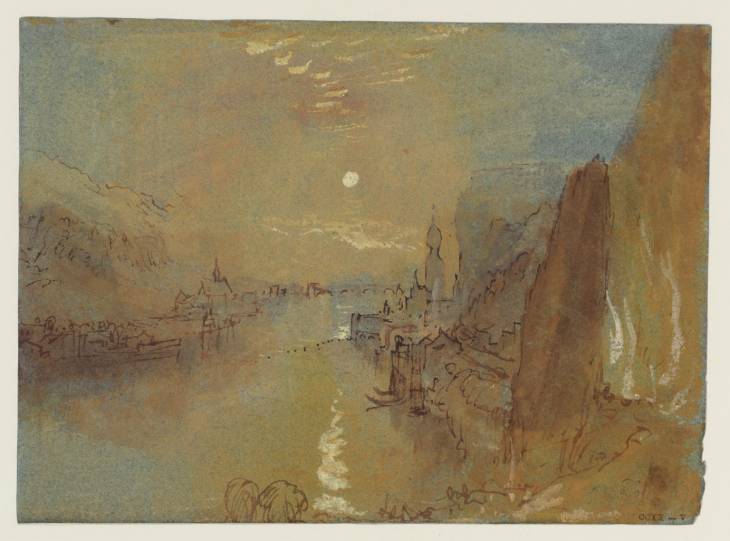Joseph Mallord William Turner Dinant from the Roche à Bayard: Moonlight 1839
Joseph Mallord William Turner,
Dinant from the Roche à Bayard: Moonlight
1839
Joseph Mallord William Turner 1775–1851
Dinant from the Roche à Bayard: Moonlight 1839
D20229
Turner Bequest CCXX V
Turner Bequest CCXX V
Watercolour, gouache and pen and ink on blue wove paper, 138 x 188 mm
Blind-stamped with Turner Bequest monogram bottom right
Stamped in black ‘CCXX V’ bottom right
Blind-stamped with Turner Bequest monogram bottom right
Stamped in black ‘CCXX V’ bottom right
Accepted by the nation as part of the Turner Bequest 1856
Exhibition history
1904
National Gallery, London, various dates to at least 1904 (185, as ‘Dinant’).
1939
Aberystwyth, ?November 1939–1939 (no catalogue, but numbered frame no.4).
1939
Grande Saison internationale de l’eau, Liège, May–September 1939 (frame no.4).
1953
Display of Watercolours from the Turner Bequest, Tate Gallery, London, January 1953–April 1959 (no catalogue, but numbered I:18b, as Dinant).
1982
J.M.W. Turner Watercolors from the British Museum, Georgia Museum of Art, University of Georgia, Athens, March–May 1982, Museum of Fine Arts, Houston, May–July 1982 (40, reproduced as Dinant on the Meuse: Looking Downstream).
1983
Turner Abroad: Watercolours from the Turner Bequest Loaned by the British Museum, Tate Gallery, London, June–December 1983 (no catalogue).
1984
J.M.W. Turner in Luxembourg and its neighbourhood, Musée de l’Etat, Luxembourg, March–April 1984 (34, reproduced as Vue de Dinant (Meuse): le rocher Bayard).
1991
Turner’s Rivers of Europe: The Rhine, Meuse and Mosel, Tate Gallery, London, September 1991–January 1992, Musée Communal d’Ixelles, Brussels, February–April 1992 (99, reproduced, and in colour [p.85]).
1995
Sketching the Sky: Watercolours from the Turner Bequest, Tate Gallery, London, September 1995–February 1996.
1998
Moonlight and Firelight: Watercolours from the Turner Bequest, Tate Gallery, London, July–November 1998 (no catalogue, but numbered 8).
2007
Hockney on Turner Watercolours, Tate Britain, London, June 2007–February 2008.
References
1904
E.T. Cook and Alexander Wedderburn eds., Library Edition: The Works of John Ruskin: Volume XIII: Turner: The Harbours of England; Catalogues and Notes, London 1904, pp.386, 616 no.185, as ‘Dinant’.
1909
A.J. Finberg, A Complete Inventory of the Drawings of the Turner Bequest, London 1909, vol.II, p.687, as ‘Dinant’.
2010
Nicola Moorby and Ian Warrell (eds.), How to Paint like Turner, London 2010, pp.28–9.
1991
Cecilia Powell, Turner’s Rivers of Europe: The Rhine, Meuse and Mosel, exhibition catalogue, Tate Gallery, London 1991, pp.18, 41, 48, 157 no.92, 162 no.99.
1995
Sketching the Sky: Watercolours from the Turner Bequest, exhibition catalogue, Tate Gallery, London 1995, p.10.
This drawing shows the city of Dinant at twilight, with the Roche à Bayard in the foreground. A steep cleft rock formation, the Roche à Bayard is named after a magical horse given as a gift to the legendary Four Brothers of Aymon by the Emperor Charlemagne. Folklore has it that a dispute occurred between the brothers and the Emperor over a chess game, and that the Quatre Fils Aymon were subsequently forced to flee court. The four men were aided by the horse Bayard who carried them on his back and leapt over the hills of the Ardennes to safety.1 Reaching Dinant, Bayard’s mighty hooves caused part of a tall cliff to split, leaving behind the splintered pinnacle of stone now known as the Roche à Bayard.2
The monolith is recorded in a number of rough drawings in the Spa, Dinant, and Namur sketchbook; these jottings provided the various visual ‘ingredients’ with which Turner created the present gouache (see, for example, Tate D28042, D28161, D28164; Turner Bequest CCLXXXVIII 1, 64, 65a). Cecilia Powell suggests that parts of this drawing may have been taken in situ, the artist adding watercolour and gouache to it later, in the winter of 1839.3
The sun, a small circle of opaque white gouache, casts shimmering reflections on the tranquil waters of the Meuse and on the wispy cirrus clouds above. The village of Bouvignes can be seen on the west bank: its church is visible, as are the ruins of its medieval feudal stronghold, Crèvecoeur Castle.
Turner’s handling is painterly. The artist has applied broad planes of translucent mauve, brown, and yellow-green wash to wetted blue paper, so that the watercolours merge and diffuse into one another to create an evocative atmospheric effect. The contours of the citadel, Church of Notre-Dame, and surrounding valley, on the other hand, are crisply delineated in brown and black ink.
Histoire des Quatre Fils Aymon, nouvelle édition corrigée, Lille 1819. See also ‘Le Rocher Bayard’, Ville de Dinant, accessed 21 July 2014, http://www.dinant.be/patrimoine/sites/rocher-bayard
Verso:
Inscribed in pencil ‘25 b’ and ‘9’ at centre towards top right; stamped in black with Turner Bequest monogram and ‘CCXX V’ at bottom centre towards right; inscribed in pencil ‘CCXX V’ bottom centre.
Alice Rylance-Watson
June 2013
How to cite
Alice Rylance-Watson, ‘Dinant from the Roche à Bayard: Moonlight 1839 by Joseph Mallord William Turner’, catalogue entry, June 2013, in David Blayney Brown (ed.), J.M.W. Turner: Sketchbooks, Drawings and Watercolours, Tate Research Publication, November 2014, https://www

